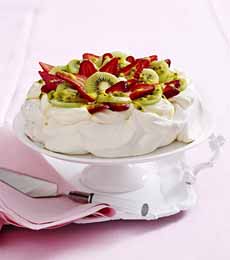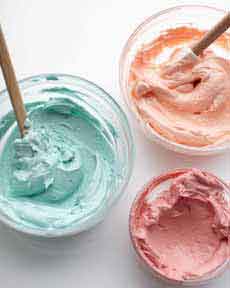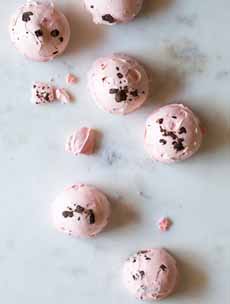TIP OF THE DAY: Types Of Meringue, Plus Red Wine Meringue Cookies
|
All meringue begins the same: with egg whites beaten with some form of sugar. But from there, pastry chefs evolved different preparation techniques to produce different results.
You may think of meringue as cookies, or dessert cups that hold fruit or mousse, like vacherins or pavlovas*. It can also be made into a cake layer (dacquoise), or float, freshly beaten, in a sea of creme anglaise. The Difference Between Pavlova & Vacherin Pavlova is a meringue-based dessert or formed into a crisp shell. It is filled with fresh fruit, ice cream, mousse and/or whipped cream. Vacherin is also made of crisp meringue, but typically formed into layers that are filled with almond paste, fruits, ice cream and/or whipped cream. Essendially, they use the same ingredients, but style them differently. (Note that vacherin is also the name of a cow’s milk cheese made in France and Switzerland). French Meringue That’s classic meringue, a dry meringue also called basic meringue. Egg whites are beaten until they form soft peaks. Then sugar—ideally superfine sugar, which you can make it by pulsing table sugar in a food processor—is slowly incorporated to maximize volume. This results in soft, airy, light peaks that stand up straight—for a while, anyway (they’ll ultimately deflate). French meringue is spooned or piped into dessert shells (such as vacherins) and cake layers (as in a dacquoise), and baked, later to be topped with fruit, mousse, or whipped cream. It is also often folded into batter to make lady fingers, sponge cakes and soufflés. A softer style of meringue, Italian meringue can top a lemon meringue pie or Baked Alaska. One of our favorite childhood desserts, Floating Island (île flottante in French), consists of beaten egg whites form into “islands” and set in a sea of custard sauce (crème anglaise). After the whites have been whipped to firm peaks, boiling sugar syrup is poured in. Whipping continues until the meringue has reached its full volume, sand is stiff and satiny. The technique delivers a more stable, soft meringue for cakes, pastries and pies, that doesn’t collapse. Italian meringue is often used to frost cakes; it can be used alone or combined with buttercream. It creates meringue toppings on pies. Here‘s a recipe. As a technique, pastry chefs use it to lighten ice cream, sorbet and mousse. Swiss Meringue Swiss meringue is whisked over a bain-marie to warm the egg whites. After the sugar is completely dissolved, the mixture is removed from the heat and beaten vigorously to attain full volume. It is then beaten at a lower speed until cool and very stiff. This forms a dense, glossy marshmallow-like meringue. It is usually then baked. Swiss meringue is smoother, silkier, and somewhat denser than French meringue and is often used as a base for buttercream frostings. Here’s a recipe from Martha Stewart. MERINGUE-MAKING TIPS Only a pinch of red wine sea salt is used, to garnish; so if you don’t have/want to make red sea salt (the recipe is below), look to see what you do have; lavender or rosemary sea salt, for example. In a pinch (pun intended), you can use plain kosher salt or coarse sea salt. Ingredients 1. HEAT the wine and sugar to a rolling boil, in a saucepan over high heat. 2. ADD the egg whites to a clean bowl and mix at high speed, until the egg white is all frothy and starts to form soft peaks. When the wine comes to a rolling boil… 3. LET the wine boil for another 60 seconds, remove from the heat and pour into a measuring cup with a lip, or other easy-pouring vessel. With the mixer on high… 4. SLOWLY pour the wine down the sides of the bowl. Continue to mix at high speed until the hot mixture reaches room temperature (the volume will continue to increase). Turn off the engine of the mixer once the mixture has cooled down. |
[1] Meringue cookies (photo courtesy American Egg Board). [2] Pavlova: a hollow center that’s filled with strawberries (photo courtesy Rob Shaw | Bauer Media). [3] Vacherin: layers of meringue filled with fruit, etc. (here’s the recipe from Hello Magazine). [4] A vacherin variation: stacked layers of meringue garnished with fruit and whipped cream (here’s the recipe from Martha Stewart). [5] Floating island: freshly-beaten meringue in crème anglaise (here’s a recipe from Big Red Kitchen). [6]. Swiss meringue, colored to frost cakes and cupcakes (photo Johnny Miller | Martha Stewart). |
|

|
5. PREHEAT the oven to 225°F, and pipe or otherwise shape the meringue as you wish. First line baking sheets with parchment, dusted with confectioner’s sugar to prevent sticking. Then you can use a piping bag with or without nozzle (the original meringues were shaped with two spoons!). You can pipe roses, stars, or use the occasion to pipe different shapes (why must they all be uniform?). Here’s more about piping meringues. 6. BAKE for 1 hour, then remove from the oven and cool to room temperature (you can leave in the oven with the door open). If not using the same day… 7. STORE completely cooled in an airtight container, packed loosely and with room at the top, so you don’t crush them. Ingredients 1. BRING the wine to a boil in a saucepan over medium to high heat. Reduce the temperature and simmer until the liquid reduces to 1-2 tablespoons and is thicker and a bit syrupy. 2. ADD 1 to 1-1/2 cups of salt For every tablespoon of reduced wine. Add one cup, stir and if the liquid hasn’t absorbed as well as you would like it to, add some more. Stir until the salt is completely covered. Spread over paper towels on a plate and let dry overnight. 3. STORE in clean air-tight jars; add a ribbon and present as a gift. HERE’S MORE ABOUT MAKING YOUR OWN FLAVORED SALTS. It’s easy, it’s great for gifting, and you’ll save a fortune! Check it out. Here’s more about flavored salts—not all are made from actual sea salt. Conventional salt is less expensive; and when it’s flavored, you can’t detect the subtle mineral and other terroir nuances of sea salt anyway. Some sources say that that meringue was invented in the Swiss village of Meiringen in the 18th century, and improved by an Italian chef named Gasparini. Not all experts agree: The Oxford English Dictionary, for example, states that the French word is of unknown† origin. The one fact we can hang on to is that the name of the confection called meringue first appeared in print in chef François Massialot’s seminal 1691 cookbook (available in translation as The court and country cook…. The word meringue first appeared in English in 1706 in an English translation of Massialot’s book. |
|
|
Two considerably earlier 17th-century English manuscript books of recipes give instructions for confections that are recognizable as meringue. One is called “white biskit bread” in the book of recipes started in 1604 by Lady Elinor Poole Fettiplace (1570-c.1647) of Gloucestershire. The other is called “pets” in the manuscript of collected recipes written by Lady Rachel Fane (c. 1612–1680) of Knole, Kent. Slowly-baked meringues are still referred to as pets in the Loire region of France (the reference appears to be their light fluffiness, perhaps like a kitten?). Meringues were traditionally shaped between two large spoons, as they are generally at home today. Meringue piped through a pastry bag was introduced by the great French chef Marie-Antoine Carême (1784-1833—he preferred to be called Antonin), the founder of the concept of haute cuisine. He also invented modern mayonnaise, éclairs, and other icons of French cuisine. ________________ |
||







